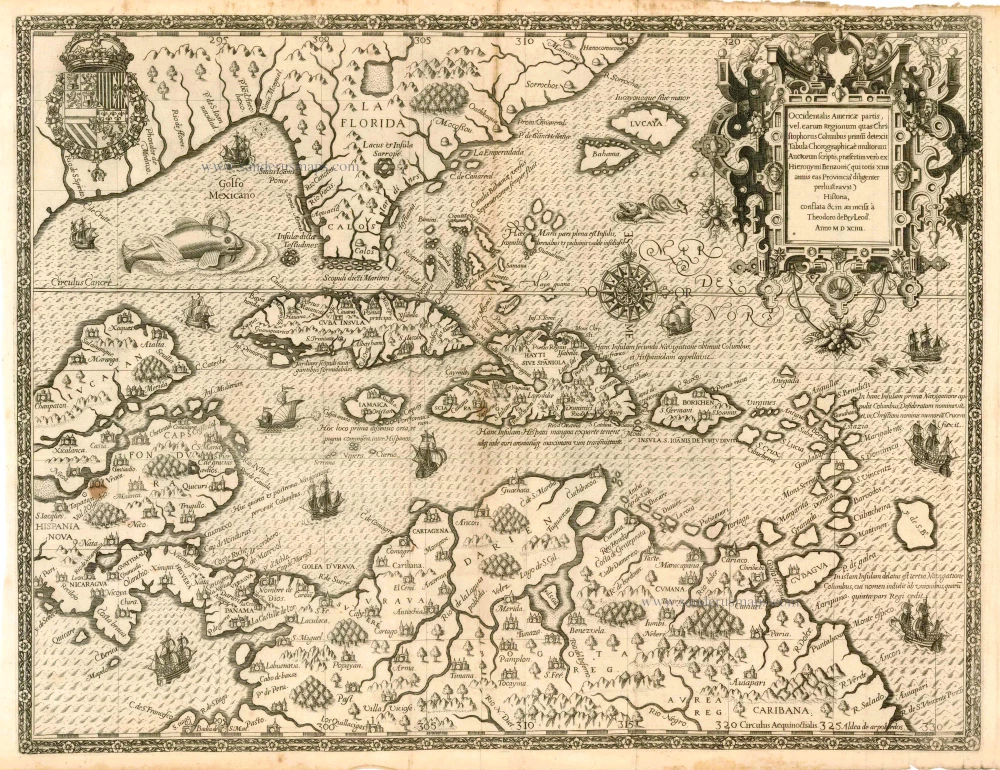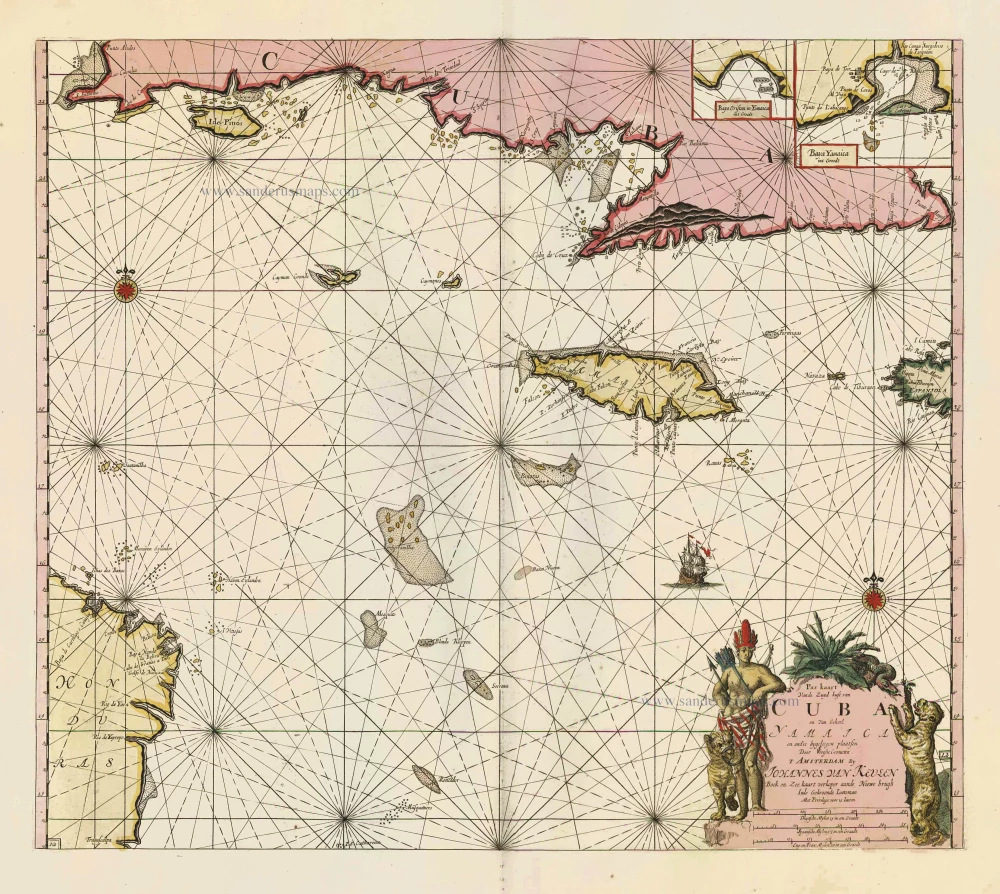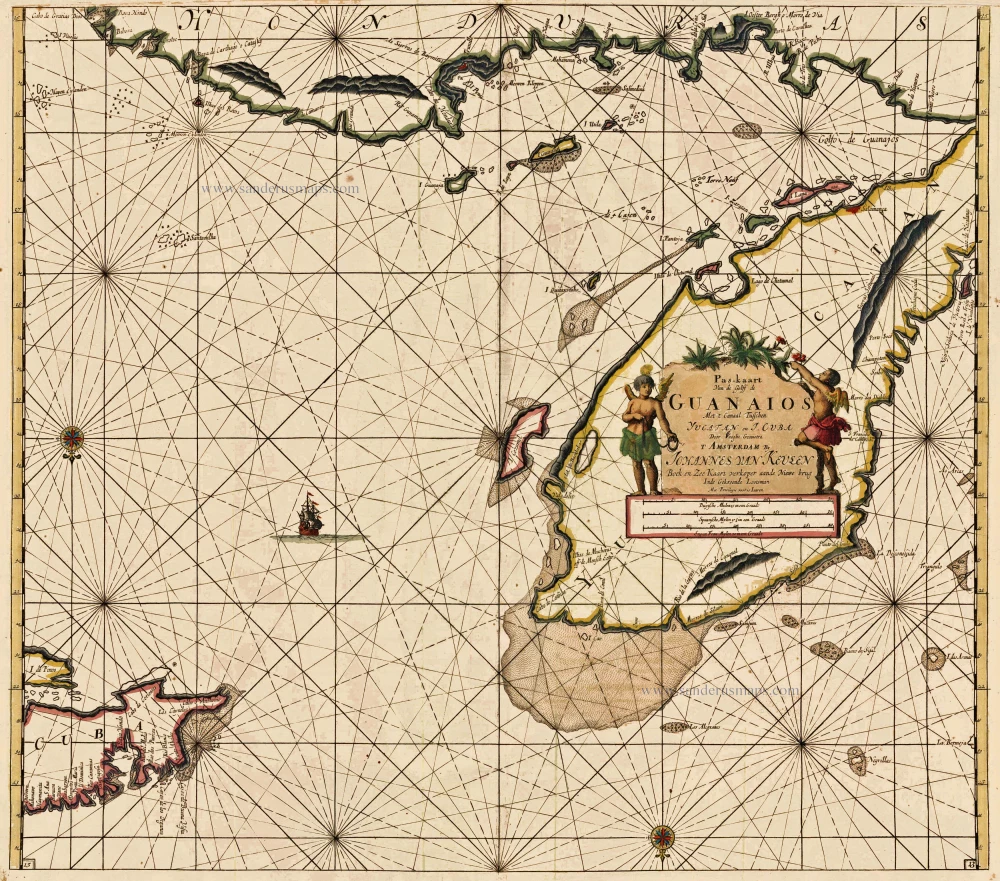Old antique map of the Caribbean Isles, by Theodore. de Bry. 1594
Girolamo Benzoni, the author of this account, travelled between 1541 and 1556 in the Caribbean Sea. Born in Milan, he travelled to the New World by working aboard a ship. He witnessed many Spanish cruelties with the Indians, with whom he seems to have had some sympathy. The book is full of illustrations of these incidents.
The beautifully engraved maps show the disproportionately sized islands of the West Indies. (Burden)
Theodore de Bry (1528 – 1598) and his family.
Theodore de Bry was born in 1528 in the Prince-Bishopric of Liège in the southern Netherlands (today Belgium). Trained as a goldsmith in his father's workshop, he left his home town around 1558 and moved to Strasbourg. Religious motives partly inspired his emigration, but commercial incentives were probably more critical for de Bry since Strasbourg was more attractive. Here, he gradually began to shift his focus to copper engraving. In the early 1560s, Theodore married Strasbourg-born Katharina Esslinger, and the couple went on to have four children together before Katharina died c. 1569. Johan Theodore (b. 1563) and Johan Israel (b. 1565) followed in their father's footsteps and took up his trade. He remarried in 1570 to Katharina Rölinger.
In 1577, after the Pacification of Gent had quietened religious tensions in the Netherlands, Theodore and his family moved to Antwerp. There, they lived close to the printing house of Christopher Plantin, and it was there that Theodore began making copper engravings. Copper engraving was a well-developed art in the Low Countries, and Antwerp artists were in great demand. In 1584, when Catholic troops besieged Antwerp, Theodore and his family moved to London, where he made copper engravings for an essential English navigation manual, The Mariners Mirrour. He also found the inspiration to produce the collection to which his name would forever be attached.
He met the artist Jacques Le Moyne de Morgues, a draughtsman who had been to Florida in the 1560s as part of a French expedition. He returned to Europe with watercolours of the natural world he had seen and the indigenous peoples. After Le Moyne's death, thanks to the mediation of Richard Hakluyt, Theodore acquired these drawings.
Hakluyt and de Bry began collaborating on a series of books about America. In 1588, the de Bry family moved to Frankfurt, where Theodore published the first volume of the America series. This first volume was the only one in the collection that appeared in four different languages: German, Latin, French and English. The following volumes appeared only in German and Latin. As a result, the relationship between de Bry and his English partners quickly soured.
Theodore continued publishing and produced a blend of richly illustrated prestigious volumes of the Voyages collection, the family firm's flagship publication.
Theodore de Bry died on March 27th, 1598. At this time, the highly successful and lucrative America series had already extended to seven volumes, and there would be fourteen. To these must be added the 'Elenchus', published in 1634 by Merian, which was a collective title and table of contents of these same volumes.
In 1597, the de Bry brothers published the first volume of the East India series. These were also published in folio but with slightly smaller page sizes than the America volumes. To distinguish the East India series from his America series, the two parallel sets subsequently became known among bibliophiles as de Bry’s Petits Voyages and his Grands Voyages, respectively.
The Petits Voyages consist of thirteen volumes, published between 1597 and 1633.
After Theodore de Bry's death, the business was run by his son, Johann Theodore and then by his grandson, Matthäus Merian and grandson-in-law, William Fitzer. Precisely what part de Bry's widow and his other son played in the business is unclear, but they certainly seemed to have retained some interest. After all, it must have become a very profitable venture for the whole family. Together, they continued to publish volumes of the Grands and Petits Voyages for another 46 years. The last volume, a third edition of Part IV of the America series, finally appeared in 1644.
Occidentalis Americae Partis, vel, Earum Regionum quas Christophorus Columbus Primu Detexit Tabula Chorographicae Multorum Auctorum Scriptis, Praesertim Vero ex Hieronymi Benzoni ... Theodoro de Bry Leod. Anno M D XCIIII.
Item Number: 5167 Authenticity Guarantee
Category: Antique maps > America > West Indies
Old antique map of the Caribbean Isles, by Theodore. de Bry.
Title: Occidentalis Americae Partis, vel, Earum Regionum quas Christophorus Columbus Primu Detexit Tabula Chorographicae Multorum Auctorum Scriptis, Praesertim Vero ex Hieronymi Benzoni ... Theodoro de Bry Leod. Anno M D XCIIII.
Date of the first edition: 1594.
Date of this map: 1594.
Copper engraving, printed on paper.
Size (not including margins): 330 x 440mm (12.99 x 17.32 inches).
Verso: Blank.
Condition: Small stain at left, else excellent.
Condition Rating: A+.
From: Benzoni G. Americae Pars Quarta Insignis & Admiranda Historia.
Benzoni's work is Part 4 of Theodorus de Bry's Collectiones Peregrinationum in Indiam Occidentalem. (25 parts) Frankfurt, 1590-1634. (= Grands Voyages)
Girolamo Benzoni, the author of this account, travelled between 1541 and 1556 in the Caribbean Sea. Born in Milan, he travelled to the New World by working aboard a ship. He witnessed many Spanish cruelties with the Indians, with whom he seems to have had some sympathy. The book is full of illustrations of these incidents.
The beautifully engraved maps show the disproportionately sized islands of the West Indies. (Burden)
Theodore de Bry (1528 – 1598) and his family.
Theodore de Bry was born in 1528 in the Prince-Bishopric of Liège in the southern Netherlands (today Belgium). Trained as a goldsmith in his father's workshop, he left his home town around 1558 and moved to Strasbourg. Religious motives partly inspired his emigration, but commercial incentives were probably more critical for de Bry since Strasbourg was more attractive. Here, he gradually began to shift his focus to copper engraving. In the early 1560s, Theodore married Strasbourg-born Katharina Esslinger, and the couple went on to have four children together before Katharina died c. 1569. Johan Theodore (b. 1563) and Johan Israel (b. 1565) followed in their father's footsteps and took up his trade. He remarried in 1570 to Katharina Rölinger.
In 1577, after the Pacification of Gent had quietened religious tensions in the Netherlands, Theodore and his family moved to Antwerp. There, they lived close to the printing house of Christopher Plantin, and it was there that Theodore began making copper engravings. Copper engraving was a well-developed art in the Low Countries, and Antwerp artists were in great demand. In 1584, when Catholic troops besieged Antwerp, Theodore and his family moved to London, where he made copper engravings for an essential English navigation manual, The Mariners Mirrour. He also found the inspiration to produce the collection to which his name would forever be attached.
He met the artist Jacques Le Moyne de Morgues, a draughtsman who had been to Florida in the 1560s as part of a French expedition. He returned to Europe with watercolours of the natural world he had seen and the indigenous peoples. After Le Moyne's death, thanks to the mediation of Richard Hakluyt, Theodore acquired these drawings.
Hakluyt and de Bry began collaborating on a series of books about America. In 1588, the de Bry family moved to Frankfurt, where Theodore published the first volume of the America series. This first volume was the only one in the collection that appeared in four different languages: German, Latin, French and English. The following volumes appeared only in German and Latin. As a result, the relationship between de Bry and his English partners quickly soured.
Theodore continued publishing and produced a blend of richly illustrated prestigious volumes of the Voyages collection, the family firm's flagship publication.
Theodore de Bry died on March 27th, 1598. At this time, the highly successful and lucrative America series had already extended to seven volumes, and there would be fourteen. To these must be added the 'Elenchus', published in 1634 by Merian, which was a collective title and table of contents of these same volumes.
In 1597, the de Bry brothers published the first volume of the East India series. These were also published in folio but with slightly smaller page sizes than the America volumes. To distinguish the East India series from his America series, the two parallel sets subsequently became known among bibliophiles as de Bry’s Petits Voyages and his Grands Voyages, respectively.
The Petits Voyages consist of thirteen volumes, published between 1597 and 1633.
After Theodore de Bry's death, the business was run by his son, Johann Theodore and then by his grandson, Matthäus Merian and grandson-in-law, William Fitzer. Precisely what part de Bry's widow and his other son played in the business is unclear, but they certainly seemed to have retained some interest. After all, it must have become a very profitable venture for the whole family. Together, they continued to publish volumes of the Grands and Petits Voyages for another 46 years. The last volume, a third edition of Part IV of the America series, finally appeared in 1644.



